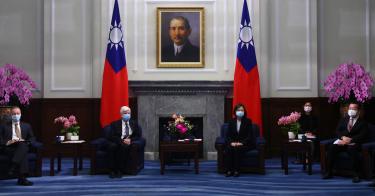How should the U.S. respond in the event of a Chinese invasion of Taiwan?
The answer to this question is often presumed to be the same as if an adversary were to invade NATO, Japan or South Korea, in which case the United States would respond promptly and forcefully to
But the reality is that Taiwan is not quite the same as any of these other partners.
To begin with, the United States does not diplomatically “recognize”
>>> Why U.S.-Taiwan Relations Are Partnership for Freedom
Hedging its bets, however, and not wanting to simply walk away from the people of Taiwan (the way the U.S. had in South Vietnam several years earlier), Congress enacted the Taiwan Relations Act (TRA), to govern U.S. relations with the island.
The TRA is a law, not quite the same as a binding treaty, such as those that undergird the NATO alliance or the commitments to Japan and South Korea. While the authors tried to approximate best they could the U.S.-ROC security treaty the TRA replaced, the TRA does not contain the treaty’s explicit commitment to “act to meet the common danger.”
This does not mean that the United States can walk away from its multi-decade commitment to Taiwan without cost, however. The TRA did establish long-standing policy that “any effort to determine the future of Taiwan by other than peaceful means… (would be) a grave concern to the U.S.,” and that the president and Congress would determine appropriate action in response to such danger.
This is close enough to a security commitment that a failure to respond to an act of naked aggression by the PRC against Taiwan would raise real questions about American commitments to those treaty allies. Coming in within 10 years of U.S. failure to enforce the Syrian red line after Bashar al-Assad’s use of chemical weapons (when then Secretary of State John Kerry famously declared that Assad staying in power was a “non-starter”); and the inconclusive conclusion to the two-decade war in Afghanistan, American allies would rightfully wonder what the value of an American security commitment actually is.
More to the point, a Chinese victory over Taiwan would drastically alter the strategic environment in the western Pacific. The so-called “first island chain,” stretching from Japan through Okinawa, Taiwan, the Philippines, to the Straits of Malacca can serve as a shield for both sides. In Western hands, it limits China’s ability to break out into the central Pacific where it can threaten Japan and South Korea’s sea lines of communications, and imposes attrition on Chinese forces trying to roll back the U.S. to Guam or Hawaii. The recent costs imposed by simply one ship blocking the Suez Canal gives a glimpse of the costs imposed on the Japanese and South Korean economies should China conquer Taiwan.
In Chinese hands, the first island chain protects China’s economic center of gravity, which has moved to the coast over the past four decades. Chinese bombers on Taiwan could more easily reach Guam, without having to detour around the island; conversely, American bombers seeking to hit Chinese targets would now be detected hundreds of miles and vital minutes earlier. Similarly, American submarines hoping to snipe at Chinese naval forces and its merchant marine would now have to transit well-known gaps in the island chain.
>>> Building a Robust U.S.-Taiwan Economic Dialogue
Most important, however, is the question of the nature of the war that a Chinese invasion of Taiwan would begin. Over the past several years, Chinese leader Xi Jinping has demonstrated his willingness to flout both international treaties and “the good opinion of all mankind.” The crackdown on Hong Kong is in direct contravention of the Sino-British Joint Declaration, which guaranteed a “high-degree of autonomy” for 50 years. That agreement seems to have expired over two decades early.
Above all, it would demonstrate that Beijing has concluded that the general status quo that has ruled the Taiwan Straits region for the last six decades is no longer acceptable. Threats, coercion, and intimidation are already testing that status quo, but an open invasion—which would jeopardize not only the population of Taiwan but the thousands of Americans, Japanese, Europeans and others who are living on the island—would indicate that Beijing has truly changed its view of its intended relations with the rest of Asia and the world.
Would a China that successfully takes Taiwan really halt with just the island? Especially once doing so would strategically isolate South Korea and Japan, critical U.S. treaty allies, two of the most important economies and sources of American technology, in the world? Or would there then follow one final territorial demand after another? What would be a clearer signal that China is not only intent on changing the world to suit its needs, by any means necessary, but is also intent on forcing America into a supine position?
This piece originally appeared in the Daily Caller



